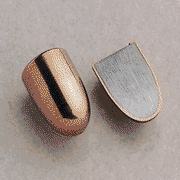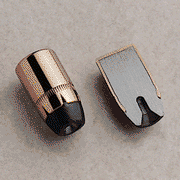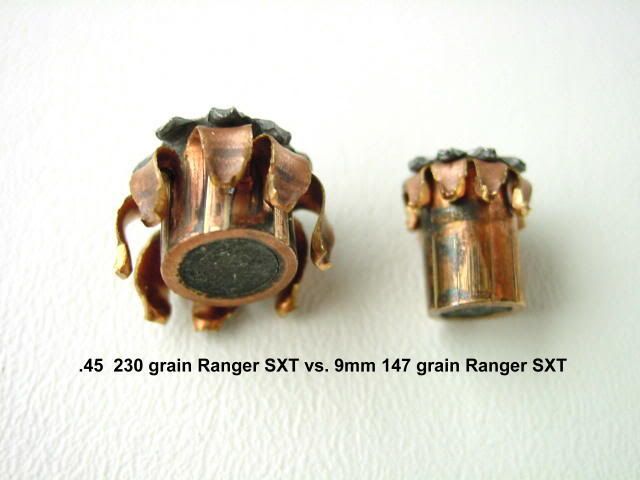A guy in my office is looking to buy his first handgun. He went to talk to me and another guy who sits close by, about it. We started asking the standard questions, and we found that our terms and the terms that he was using were not at all the same, so if you are not around guns at all, I decided to work up a little guide.
This is part two dealing with ammo. Part one dealt with gun parts. Part three will deal with types of guns and their uses.
Part I,
Part II,
Part III
Ammo, Pills, Bullets, Caps
What goes boom? It isn't gun powder. Gun powder, or black powder, hasn't been used for a very long time, and your standard auto loading pistols and rifles would not work with it, but I am getting ahead of myself. The modern firearm is based upon the self contained cartridge. By self contained, I mean everything that is needed to fire the projectile is contained in one handy package. This package is properly called a cartridge, but is also called a "round."

Never ever ever ever ever ever ever ever ever EVER call this type of cartridge a "shell." A "shell" is an entirely different kind of cartridge.
First you have the bullet, or the projectile. The bullet sits atop the propellant, smokeless powder in most cases. The propellant sits atop the primer, and the Casing holds everything together. The casing used to be, and still is in some cases, made of brass, so sometimes spent casings are called "brass."
Primers
Great, what does this mean to you? Well, the magic is in the primer. In the good old days you had to poor gun powder and ram your projectile down on top of it. A little power would be placed, or spill, in to a pan at the trigger area and when you pulled the trigger some flint or a match or something would ignite that little bit of powder. The fire from that spark would travel through a tiny hole and ignite the main charge. If the charge did not go off, it was called a "flash in the pan." So, as you can imagine, reliability was a real problem. Now a days, we took that pan charge and put it where it would always ignite the main charge, and always be in the same spot. This is called the primer. With a center fire round, the primer is on the flat end right in the center as the name implies. It is that picece of metal that is a different color than the rest of the casing.
The primer is not unlike a standard match head. In it is a little bit of explosive material that sparks when struck. There is very little explosive material in the primer, but you really don't need much, because the real boom comes from the propellant charge that is set off by the primer.
Propellant
The propellant is typically smokeless powder. Kind of a misnomer because it is really more like smokeless gravel. Anyway, it is the stuff that goes boom. The gun and the casing keep the resulting gases of this explosion pointed only one way, down the business end of the gun.
It was found that gunpowder, your saltpeter, sulfur, and charcoal mix produced a lot of smoke. This was bad for many reasons. So a new type of powder was developed, and it was found to burn better, with minimal smoke, and was much more powerful than gunpowder. This development was as big of a change in the firearm since the invention of gunpowder itself. With this cleaner, more powerful powder a person could carry more ammunition, could see what he was shooting at after the first shot, and his guns would not rust as quickly.
Another problem with gunpowder is that it just didn't burn very cleanly. It would produce a soot that would foul every gun that fired it. Smokeless powder burned very cleanly in comparison, and with nothing fouling the action of the gun, weapons that fired multiple rounds using a complex action could be produced. Without smokeless powder, the modern self loading firearm would foul with in two or three shots. With smokeless powder, the auto loading firearm becomes a reality.
There are some things that you should know about smokeless powder. First, the amount (mass) is measured in grains(gr). 1 grain = 64.79891 mg, or about 437.5 grains = 1 oz.
How much powder you can put in to a cartridge depends on how large your casing is, and how strong the barrel of the gun you are using is. Typically, there are published tolerances published for the parts of guns so that you can be sure that the round you are using isn't too hot (too much powder) for the gun. Really that is all you need to know for a beginner, if you want to know more start looking in to literature on home loading. For all intents and purposes, the stuff you buy in the store will all go through your guns no problem... Provided you bought a well maintained firearm...
As you look at ammunition you will notice that some the ammunition designated for pistols will be noted with a P, or a +P. As smokeless powder got better and stronger, not so much of it was needed to produce the same power as the older stuff. So, some cartages could handle more powder than they traditionally held with the weaker powder. After some testing, manufacturers found that they could put the full charge of the new stuff in to the cartridge and it would function just fine in the pistols they tested. So, a new designation was created.
The "P" stands for pressure. The rounds that are more powerful are called "+P." Your gun's manual will let you know if you can use the +P round. Nearly all new pistols do.
Projectile
The projectile, or the bullet, is what puts holes in things. Typical bullets are made of lead. Why? Couple of reasons. Lead is a malleable substance, in other words it is soft and easily shaped. Lead is easy to find and cheap to use. Remember that a bullet travels very fast. Sir Newton teaches us that energy is conserved, so, during a collision, that energy has to go somewhere. Because of its unique properties, Lead will not shatter when it strikes something, like iron or steel would. Lead will deform rather than shatter thus loosing its shape, but not shedding any mass. The longer you keep your mass, the more energy transfer will occur between two objects in an elastic collision.
There are all types of different bullets you can buy for all sorts of different tasks. Most often, hopefully, you will be buying Full Metal Jacket (FMJ) bullets. Lead, as you might know, is toxic. The FMJ bullet has a thin coating of steel around them. This allows them to keep their shape, allows them to be handled safely, and not leak their lead out. This round is used in target shooting.

FMJ Bullet
The other typical round that you will buy, if you are looking to hunt or use your gun for self defense, you will buy hollow point bullets. These bullets are designed to flatten out when they strike something. They transmit all of their energy in to the target. They do this by having the nose of the bullet hollowed out, thus their "hollow point" name.

Hollow Point bullet
Why is one round used for target practice and one for hunting and self defense? It has to do with how the bullets are designed, how they transmit their energy and where will the bullet end up after striking the target.
The FMJ bullet is designed to maintain its shape, that means that it is really good at passing through objects. This is great if you are worried about the environmental impact of your bullets, you aren't going to spit lead everywhere, and especially great if you are looking to minimize the tissue damage done by your bullet. Not so great if you are unsure about what is BEHIND your target. You see, a FMJ bullet maintains its energy as it passes through tissue, and , as long as it doesn't strike bone, will likely pass directly through what you are shooting at. If you don't absolutely know that something will stop your bullet directly behind your target, this is not a good round for you.
If you have ever heard of the single bullet theory behind the Kennedy assassination, that was because the bullet was a FMJ bullet.

The "magic" bullet. This passed through two people, bounced off bone, and all sorts of other stuff. Notice how it is just slightly deformed.
Hollow Points are designed to mushroom during impact to vastly expand tissue damage, and to dissapate their energy inside the target. What that means is that the bullet opens up along the hollow point. This acts like speed breaks on an airplane, only with tissue. The bullet is unlikely to have the energy to exit the body, after these breaks have been deployed. This is great if you are looking to maximize the trauma caused by the bullet. Especially great if you are not sure of what is directly behind your target. In your house for instance, if you are shooting at an intruder, do you really want your bullets passing through the bad guy, through the sheet rock, and in to your kid's bedroom? No. Hollow points for you, then.

Before and after with a hollow point. Notice how the bullet opened up.
Shotgun Ammunition
Shotgun cartridges use all the same components as other cartridges, with one very large difference. Instead of a single solid projectile, the shotgun cartridge has several balls packed close together, called "shot", and a piece of wadding to hold them in. Only shotgun cartages should be called "shells." Nothing else. Want to look like an idiot with gun guys? Call your non shotgun ammo "shells."

Shotgun shells also come with a single metal bullet, called a slug. These rounds are for hunting something other than birds.
Caliber
Caliber is the diameter of the barrel of the gun, we will get in to barrels later. Bullets are matched to the diameter of the barrel they can spin down. So if the diameter of the barrel is 0.22 inches, the ammo that you need are .22 caliber. The actual bullet's diameter will be very slightly less than 0.22 inches. Anyway, calibers are measured in inches, millimeters, and gauge in shotguns.
Millimeters and inches are accepted measures all over the world. If you don't know what they are, you shouldn't be shooting. Anyway gauge is still a diameter of the barrel of a shotgun, but it is an old school measurement for cannon having to do with the weight of a sphere of lead that could be put in to the barrel. So... a 12 gage shotgun could have a sphere of lead weighing 1/12 of a pound put down the barrel, a 20 gage 1/20 of a pound and a 410, 1/410 of a pound... wait what? No, the 410 is actually a caliber measurement. Just when you thought things were making sense right?
Gotchas
There are several "gotchas" with ammunition. Mainly having to do with the type of ammo that you need to put in to your gun. It is VERY important that you match the correct round to your gun. You could really hurt yourself, and your firearm, by using improper ammo. So what are the gotchas? With pistols, you need to make sure that they kind of ammo that you have is the kind that fits your gun... For instance, you have a .45 automatic pistol. Will .45 Colt fit? You have a 9mm pistol. Should you use 9mm Parabelum, or 9mm Luger? You have a .22 rifle. Will .22 magnum fit? Any why is a .44 round more powerful than a .45? .45 is bigger right??
The similarity in naming is what messes most people up. The .45 Colt is actually a revolver round, and the round for the .45 automatic is the .45 ACP (Automatic Colt Pistol). The 9mm Luger and 9mm Parabelum is the same round, and the .22 magnum will not fit in to a .22 Long Rifle. You need to read your gun's owner's manual very carefully to prevent any mistakes. It could mean the difference between a fun day at the range, or a painful trip to the ER.

Next Section - Gun Types









